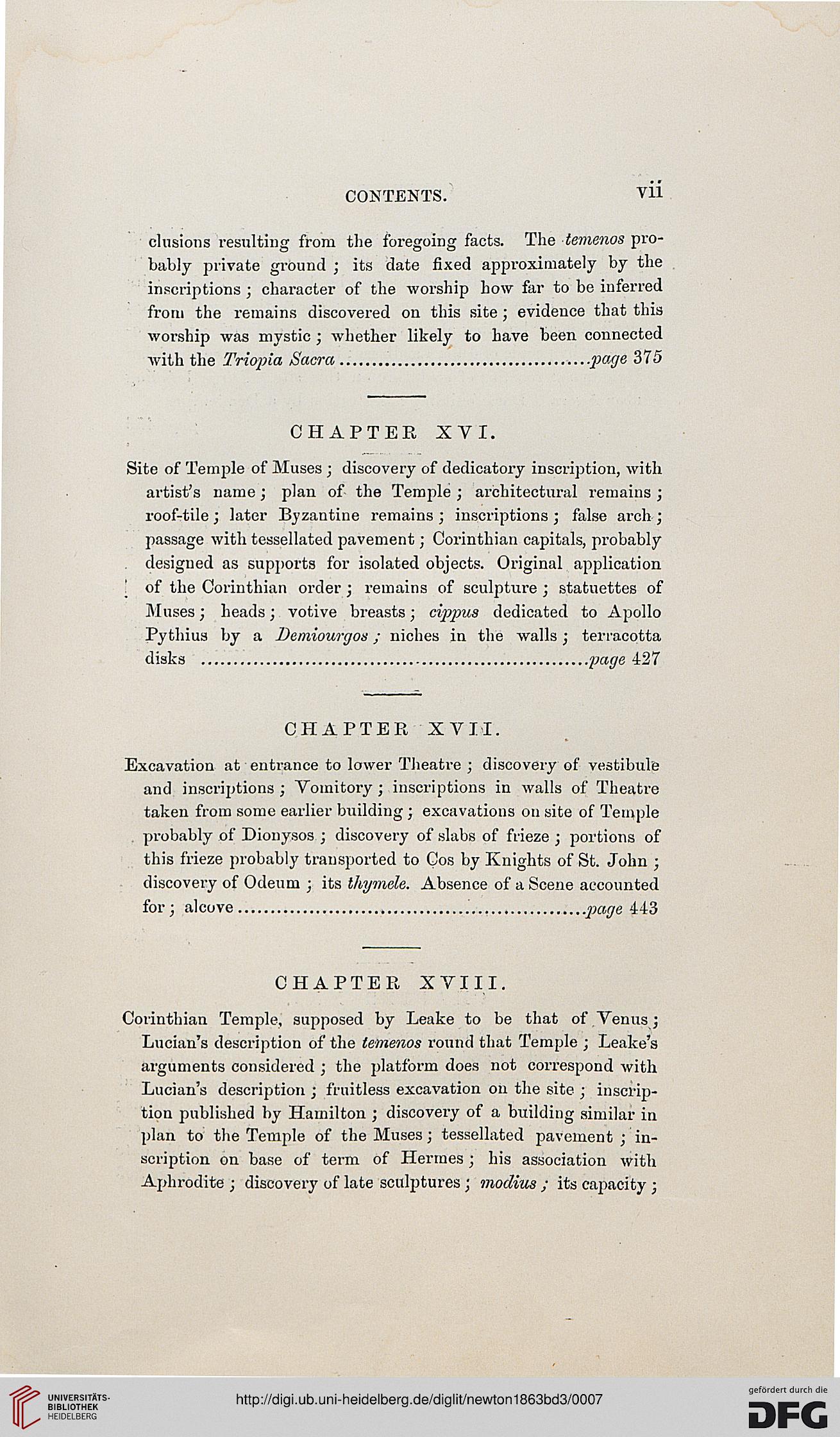CONTENTS. Vll
elusions resulting from the foregoing facts. The temenos pro-
bably private ground ; its date fixed approximately by the
inscriptions ; character of the worship how far to bo inferred
from the remains discovered on this site; evidence that this
worship was mystic ; whether likely to have been connected
with the Triopia Sacra.......................................page 375
CHAPTER XVI.
Site of Temple of Muses ; discovery of dedicatory inscription, with
artist's name ; plan of the Temple ; architectural remains ;
roof-tile; later Byzantine remains; inscriptions; false arch;
passage with tessellated pavement; Corinthian capitals, probably
designed as supports for isolated objects. Original application
of the Corinthian order ; remains of sculpture ; statuettes of
Muses; heads; votive breasts; cippus dedicated to Apollo
Pythius by a Demiourgos; niches in the walls; terracotta
disks ............................................................page 427
CHAPTER XVII.
Excavation at entrance to lower Theatre ; discovery of vestibule
and inscriptions ; Vomitory ; inscriptions in walls of Theatre
taken from some earlier building ; excavations on site of Temple
probably of Dionysos ; discovery of slabs of frieze ; portions of
this frieze probably transported to Cos by Knights of St. John ;
discovery of Odeum ; its thymele. Absence of a Scene accounted
for; alcove......................................................page 443
CHAPTER XVIII.
Corinthian Temple, supposed by Leake to be that of Venus;
Lucian's description of the temenos round that Temple ; Leake's
arguments considered ; the platform does not correspond with
Lucian's description ; fruitless excavation on the site ; inscrip-
tion published by Hamilton ; discovery of a building similar in
plan to the Temple of the Muses ; tessellated pavement ; in-
scription on base of term of Hermes ; his association with
Aphrodite ; discovery of late sculptures ; modius ; its capacity ;
elusions resulting from the foregoing facts. The temenos pro-
bably private ground ; its date fixed approximately by the
inscriptions ; character of the worship how far to bo inferred
from the remains discovered on this site; evidence that this
worship was mystic ; whether likely to have been connected
with the Triopia Sacra.......................................page 375
CHAPTER XVI.
Site of Temple of Muses ; discovery of dedicatory inscription, with
artist's name ; plan of the Temple ; architectural remains ;
roof-tile; later Byzantine remains; inscriptions; false arch;
passage with tessellated pavement; Corinthian capitals, probably
designed as supports for isolated objects. Original application
of the Corinthian order ; remains of sculpture ; statuettes of
Muses; heads; votive breasts; cippus dedicated to Apollo
Pythius by a Demiourgos; niches in the walls; terracotta
disks ............................................................page 427
CHAPTER XVII.
Excavation at entrance to lower Theatre ; discovery of vestibule
and inscriptions ; Vomitory ; inscriptions in walls of Theatre
taken from some earlier building ; excavations on site of Temple
probably of Dionysos ; discovery of slabs of frieze ; portions of
this frieze probably transported to Cos by Knights of St. John ;
discovery of Odeum ; its thymele. Absence of a Scene accounted
for; alcove......................................................page 443
CHAPTER XVIII.
Corinthian Temple, supposed by Leake to be that of Venus;
Lucian's description of the temenos round that Temple ; Leake's
arguments considered ; the platform does not correspond with
Lucian's description ; fruitless excavation on the site ; inscrip-
tion published by Hamilton ; discovery of a building similar in
plan to the Temple of the Muses ; tessellated pavement ; in-
scription on base of term of Hermes ; his association with
Aphrodite ; discovery of late sculptures ; modius ; its capacity ;





